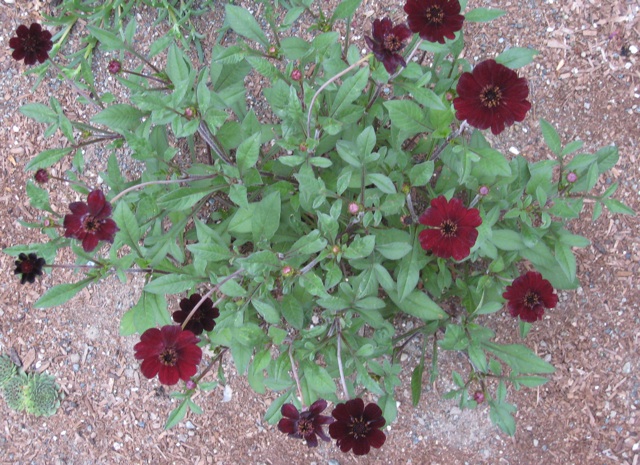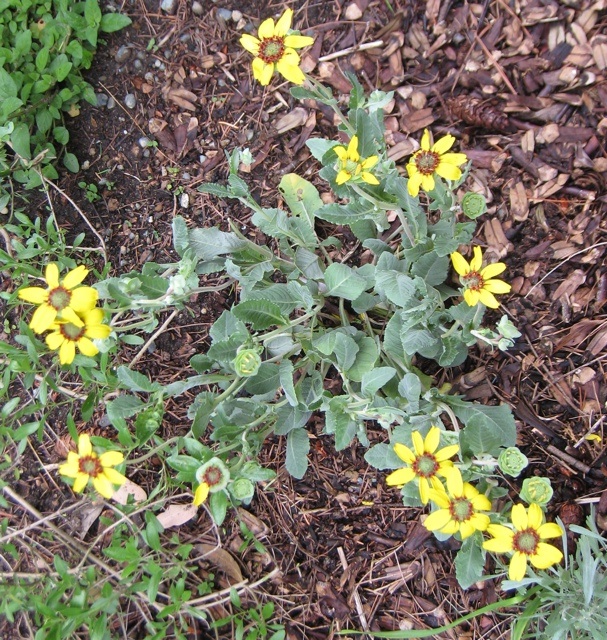Chocolate is one of humanity's favorite foods. Rich and pleasingly varied in both aroma and flavor, with endless culinary possibilities to delight both chefs and partakers, it is a plant that I would love to grow. But it is tropical and will die in Seattle winters. Perhaps the next best thing are chocolate-scented flowers? This month I feature two such. Both grow in my garden, gladden my eyes with their beauty, and my nose with the strong floral fragrance. Virtually anyone can grow these --at least in a pot. Those of us living in mild areas can overwinter them outside. Both species are readily available via mail-order nurseries.
|
| Chocolate Cosmos |
| Cosmos atrosanguineus (Hook.) Voss 1894 |
| =Cosmos diversifolius var. atrosanguineus Hook. 1861 |
=Bidens atrosanguinea (Hook.) Ortgies ex Regel 1861
|
Chocolate Cosmos has been known to me for over a decade. Its story is well known. Other names are Black Cosmos and Black Dahlia. Seeds were sent from Mexico to Europe around 1860; plants flowered and were named in 1861 in England and Switzerland. But after about 1902 it seems to have become extinct in its native east-central Mexico (from the State of San Luis Potosi southeastward to the State of Hidalgo). An early (1863) account of it in Illustrated Annual Register of Rural Affairs for 1861-2-3 by John Jacob Thomas, published in Albany, New York, stated: "This new flower was first announced in Europe last season, and as soon as flowered appeared colored plates were given in the Botanical Magazine, Beligique Horticole, and Gartenflora, while Ortgies and other florists and botanists represented it as one of the finest additions to our flowering plants . . . at first sight, it would be considered a dwarf Dahlia . . . the seed germinate readily."
|
It is commonly asserted that the plants cultivated are more or less sterile, so Chocolate Cosmos has been divided and divided by vegetative reproduction. However, though I lack the details, at least 3 cultivars or clones have been named:
|
| 'Chocamocha' (more compact; redder flowers; silver-green foliage; more fragrant) |
| 'Pinot Noir' (from New Zealand 1997) |
'New Choco' (Plant Patent No. 19223 in 2008)
|
| Moreover, Luther Burbank (1849 - 1926), the world's greatest plant breeder, worked with Chocolate Cosmos. He wrote: "Bidens atrosanguinea, a tuberous variety with dark purple flowers, is often spoken of as the black dahlia. Its tubers and foliage strongly suggest the common dahlia in miniature. For four or five years I worked extensively with this so-called black dahlia, not only by way of improving the flower itself, but also in the attempt to hybridize it with the dahlia proper. I succeeded by selective breeding in enlarging the flower to about twice its original size, in making the petals much rounder and fuller, in adding extra petals, and in changing the color of the petals from the usual dark purplish crimson to a light crimson approaching scarlet and in a few cases to a pale pink approaching white. The bush itself was also made more compact. All these changes were made by selection and re-selection" . . . p. 226 of vol. IX Luther Burbank His Methods and Discoveries and Their Practical Application 1914. |
| Chocolate Cosmos is indeed a close Dahlia relative, and has slender tuberous roots. There are about 26 species in the genus Cosmos, and Japanese plant hybridizers have crossed some with Chocolate Cosmos. But so far only soft fragrance has carried through. Plant patents have been assigned to some of these hybrids. |
Chocolate Cosmos is ideally grown in a pot (to get added warmth to its roots), with rich soil, much warmth, and adequate summer watering. It will bloom from June until frost. The flowers are velvety and darkest red; in Latin atrosanguineus means deep blood-red colored --referring more to the color of dried blood in this case. Whether it is grown in the ground or in a pot, dead-heading it certainly makes it look less ratty, and likely encourages more flowers.
|
| Chocolate Flower |
Berlandiera lyrata Benth. 1839
|
| I have only cultivated a plant of Chocolate Flower since May of 2008, so my knowledge is very limited. In general this species is less known than Chocolate Cosmos. Other names are: Chocolate-Scented Daisy, and Lyreleaf Greeneyes. The Berlandiera genus of 5 species was named after Jean Louis Berlandier (1805 - 1851). Berlandier, from Belgium, lived in Mexico and sent many plants from there. |
Chocolate Flower is native in Mexico, north to Colorado and Kansas. A night bloomer, its bright yellow flowers are chocolate scented in the morning and drop petals each day as the temperature rises. My specimen bore few flowers last summer. Maybe this year it will bear more because it is older and larger. In the wild, it can flower nearly year round. In the wild it is said to grow in dry, sandy loams, rocky, limestone soils, roadsides, grasslands with mesquite, oak, and juniper. Perhaps in my garden the soil was too rich, and the warmth and sun too scarce. But the individual flowers lasted a long time. If I acquire a second plant, I will try it in a drier, poorer soil. The Sunset Western Garden Book says it thrives in clay soil.
Back |

Chocolate Cosmos photo by ALJ |

Chocolate Flower photo by ALJ |

